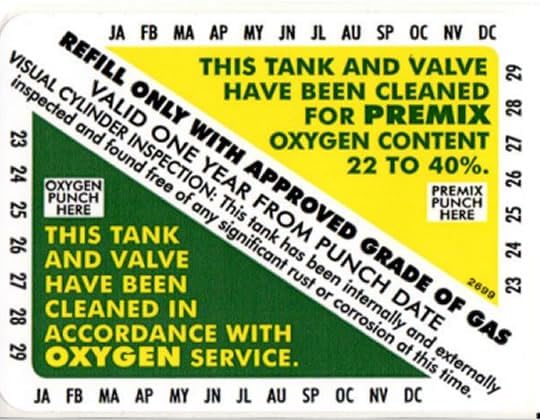Steel Tanks (Cylinders)
Only steel tanks on this page, or visit Aluminum Tanks (Cylinders).
For rebreathers, visit CCR Cylinders & Valves
-
 Faber F8-HP133 Cylinder w/Boot, GreyAs low as $484.00
Faber F8-HP133 Cylinder w/Boot, GreyAs low as $484.00 -
 Faber F8-HP117 Cylinder w/Boot, Hot Dipped GalvanizedAs low as $454.00
Faber F8-HP117 Cylinder w/Boot, Hot Dipped GalvanizedAs low as $454.00 -
 Faber F7-HP120 Cylinder w/Boot, GreyAs low as $414.00
Faber F7-HP120 Cylinder w/Boot, GreyAs low as $414.00 -
 Faber F7-HP100 Cylinder w/Boot, GrayAs low as $404.00
Faber F7-HP100 Cylinder w/Boot, GrayAs low as $404.00 -
 Faber F7-HP80 Cylinder w/Boot, GreyAs low as $314.00
Faber F7-HP80 Cylinder w/Boot, GreyAs low as $314.00 -
 Faber LP85 Cylinder w/Boot, GrayAs low as $349.00
Faber LP85 Cylinder w/Boot, GrayAs low as $349.00 -
 Faber LP50 Cylinder, GreyAs low as $299.00
Faber LP50 Cylinder, GreyAs low as $299.00 -
 Faber FX23 (3L) Cylinder, WhiteAs low as $254.00
Faber FX23 (3L) Cylinder, WhiteAs low as $254.00 -
 Faber FX23 (3L) Cylinder, BlackAs low as $254.00
Faber FX23 (3L) Cylinder, BlackAs low as $254.00 -
 Faber FX15 (2L) Cylinder, WhiteAs low as $244.00
Faber FX15 (2L) Cylinder, WhiteAs low as $244.00 -
 Faber FX15 (2L) Cylinder, BlackAs low as $244.00
Faber FX15 (2L) Cylinder, BlackAs low as $244.00 -
 DGX Custom - Steel Cylinder Sidemount PackagesAs low as $658.00
DGX Custom - Steel Cylinder Sidemount PackagesAs low as $658.00 -
 DGX Custom - Faber HP Doubles PackagesAs low as $889
DGX Custom - Faber HP Doubles PackagesAs low as $889 -
 DGX Custom - Faber LP85 Doubles PackageAs low as $959.00
DGX Custom - Faber LP85 Doubles PackageAs low as $959.00 -
 DGX Custom - Faber LP50 Doubles PackageAs low as $859
DGX Custom - Faber LP50 Doubles PackageAs low as $859
 WARNING
WARNING
SCUBA Cylinder Neck Threads and Pressures in North America
The most common service pressures seen in modern SCUBA tanks are 2640 psi, 3000 psi, 3300 psi, 3442 psi, and 3500 psi. The 2640 psi low-pressure steel tanks are preferred by Nitrox and technical divers who expect to be blending their gases using the partial-pressure method. Most aluminum SCUBA tanks are rated for 3000 psi. The compact aluminum tanks and the standard AL100 tank have a service pressure of 3300 psi. The availability of modern design high-pressure 3442 psi steel tanks manufactured under DOT Special Permit (previously termed an exemption from the old 3AA class design) caused many experienced divers to re-think their tank preferences. Although there are 3500 psi cylinders still in service, current DOT rules prohibit the transport of metal scuba cylinders on public roads with pressures above 3442 psi (230 bar), even if the cylinders have been rated for higher pressures.
Today, the most common thread form used with SCUBA cylinders and valves is National Pipe Straight - Mechanical also known as NPSM. The specific thread form used with most SCUBA cylinders is named 0.750-14 NPSM, often referred to as 3/4 NPS. This thread form is widely seen on both steel and aluminum SCUBA cylinders with service pressures of 2640, 3000, 3300 and 3442 psi.
When the now defunct Pressed Steel Tank Company (PST) manufactured a high-density steel 3500 psi service pressure SCUBA cylinder from the late 1980's until the early 2000's, they used a thread form for the neck opening known as Unified National Standard Fine. These cylinders were often sold under the brand "Sherwood Genesis" cylinders, and a similar version was occasionally imported from Japan under the name "Asahi". The specific thread form used with the steel 3500 psi SCUBA cylinder is named 0.875-14 UNF, often referred to as 7/8 UNF.
It's very important to understand that the 3/4 NPS and 7/8 UNF trade descriptions do NOT indicate relative sizes of the physical dimensions of the opening! This is because the two thread forms are from two different standards, and the names used to describe them refer to only the trade size and schedule. The 3/4 NPS opening is visibly larger than the 7/8 UNF opening. There are two different high-pressure steel SCUBA Tanks in wide use, the newer 3442 psi cylinders with 3/4 NPS threaded opening and the older 3500 psi cylinders with 7/8 UNF threaded opening. Also, Luxfer produced a limited run of SCUBA cylinders that are a composite design: aluminum shell with fiberglass hoop wraps. This cylinder has a service pressure of 4350 psi and 7/8 UNF neck threads (but almost no dive shop is capable of filling to that pressure.)
So how do you figure out what you have? Assuming your cylinder was manufactured exclusively for the North American SCUBA market in the last 50 years or so, look at the SCUBA Tank neck for the DOT stamp. The last four digits of the DOT stamp are the cylinder pressure (if the hydro date has + at the end then add 10%.) If the stamp reads DOT-3AL or DOT-3AA it almost certainly has a 3/4 NPS threaded neck opening. (3AL means aluminum, 3AA means steel.) If it reads DOT-Xxxxx-3442 it's a steel cylinder, also with 3/4 NPS threaded opening. If it reads DOT-Xxxxx-3500 or DOT-Xxxxx-4350, it's a steel or composite cylinder with a 7/8 UNF threaded opening. (The Xxxxx is a manufacturer specific four or five digit exemption number that starts with the letters E or SP.) Another test, if the valve is out of the cylinder, is that a U.S. quarter coin will fit through the 3/4 NPS cylinder neck opening but will not fit through the 7/8 UNF opening.
If your cylinder is not designed for use in recreational SCUBA or is very old, it probably also has an incompatible neck thread form. There are also some extremely rare small cylinders used for inflation and rebreather diving applications that use special valves not commonly seen in SCUBA. SCUBA cylinders manufactured primarily for the European market have either "M18X1.5" or "M25X2" ISO metric neck threads which look similar but are NOT compatible. If you are unable to determine the neck thread form of your cylinder with absolute certainty, consult a local cylinder inspection and testing facility because mismatched threads are very dangerous.

